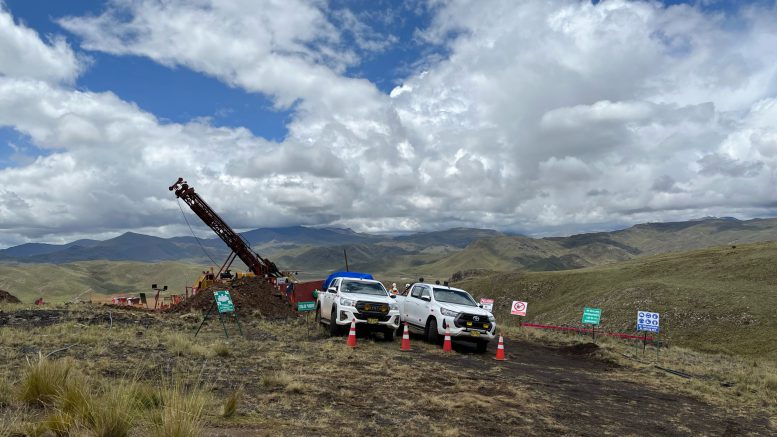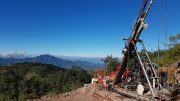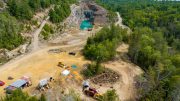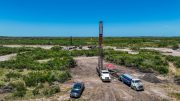Gold and silver have played an important role in society for centuries, and in more recent years, the green energy transition has fuelled demand for silver. Here’s a list of eight companies exploring for more sources of the highly coveted metals.
Aftermath Silver
Aftermath Silver (TSXV: AAG; US-OTC: AAGFF) has projects in in Chile (Challacollo and Cachinal) and Peru (Berenguela).
Challacollo is a low-sulphidation epithermal deposit in Region I of northern Chile, 130 km southeast of the port city of Iquique and 30 km east of the Pan American Highway. The project can be accessed via Teck Resources’ (TSX: TECK.A; TECK.B; NYSE: TECK) Quebrada Blanca copper mine road.
Challacollo hosts 6.6 million indicated tonnes grading 165 grams silver per tonne and 0.27 gram gold for 35.2 million oz. contained silver and 58,000 oz. gold. Inferred resources add 2.8 million tonnes averaging 124 grams silver and 0.17 gram gold, for 11.1 million oz. contained silver and 15,000 oz. gold.

Spartan Resources’ Dalgaranga project in Western Australia. Credit: Spartan Resources
Aftermath’s Chachinal low-sulphidation epithermal project is in Chile’s Region II, about 40 km east of the Pan American Highway and 16 km north of Austral Gold’s (TSXV: AGLD; ASX: AGD; US-OTC: AGLDF) Guanaco gold-silver mine.
Aftermath has defined a shallow resource of 5.1 million indicated tonnes grading 101 grams silver and 0.13 gram gold for 16.3 million oz. silver and 21.7 million oz. gold. Inferred resources add 530,000 tonnes averaging 145 grams silver and 0.15 gram gold for 2.5 million oz. silver and 2.6 million oz. gold.
In Peru, Berenguela is a carbonate replacement deposit 350 km by rail from the port of Matarani. Mineralization outcrops and metallurgical test work is underway to confirm flow sheets for silver doré, copper cathode and manganese sulphate. In February, the company reported producing battery grade 99.98% pure manganese sulphate crystals, which assayed 31.9% manganese (high purity manganese sulphate monohydrate).
Berenguela holds 40.2 million measured and indicated tonnes grading 78 grams silver, 6.1% manganese, 0.67% copper and 0.34% zinc for contained metal of 101.2 million oz. silver, 2.5 million tonnes manganese, 589 million lb. copper, and 299.3 million lb. zinc.
Inferred resources total 22.3 million tonnes grading 54 grams silver, 3.57% manganese, 0.42% copper and 0.25% zinc for 38.8 million oz. silver, 800,000 tonnes manganese, 204.3 million lb. copper and 123 million lb. zinc.
Aftermath Silver has a market cap of about $66.3 million.
Apollo Silver
Apollo Silver (TSXV: APGO; US-OTC: APGOF) is a pure play silver explorer focused on its Calico project in California’s San Bernadino County, about 15 km northeast of Barstow.
The project consists of two adjacent properties, Waterloo and Langtry, both of which have near-surface resources.
Waterloo hosts 34.2 million measured and indicated tonnes grading 100 grams silver for 110 million oz. contained silver and another 290,000 inferred tonnes grading 77 grams silver for 720,000 silver ounces. In addition to silver, Waterloo has an inferred resource of 70,000 oz. of oxide gold contained within 4.5 million tonnes grading 0.5 gram gold.

Drilling at Viscount Mining’s Cherry Creek project in Nevada. Credit: Viscount Mining
Pan American Silver (TSX: PAAS; NYSE: PAAS) has a 2% net smelter return royalty on the Waterloo property.
Langtry has inferred resources of 19.3 million tonnes averaging 81 grams silver for 50 million oz. contained silver.
The company believes that barite could become a significant byproduct credit at Calico. Results from a 2022 metallurgical test program for Waterloo produced a concentrate with 94.6% barite via flotation. Barite is on the United States’ 2022 critical minerals list and is used in domestic applications in the energy industry. About 90% of the barite sold in the U.S. is used as a weighting agent in petroleum drilling, Apollo says.
In January, the company reported that it had received both its drilling permit for Waterloo and results from this year’s assay testing program, which will be used to define barite assaying for an initial barite resource.
A historic resource estimate in 1979 for in-ground barite at Waterloo by the American Smelting and Refining Company (ASARCO), a U.S.-based subsidiary of Grupo Mexico, estimated there were 33.9 million tonnes of barite mineralized rock, grading 13.4% barite for a total of 4.5 million tonnes. ASARCO estimated that a concentrate grade of 93% could be produced at a barite recovery of 50% via flotation of cyanide tailings.
Apollo Silver has a market cap of about $28 million.
Kingsmen Resources
Kingsmen Resources (TSXV: KNG; US-OTC: KNGRF) is focused on the Las Coloradas silver-gold-lead-zinc-copper project in Mexico, about 38 km from the city of Hidalgo de Parral in northern Chihuahua state.
ASARCO conducted mining in the Las Coloradas project area between 1944 and 1952 with production from the La Soledad, Santo Nino, Eva and Rosario veins.
The project consists of shallow, high-grade silver-gold-lead-zinc-copper quartz-calcite veins and the company notes that mineralized structures have not been explored to depth or along strike. This year the company is planning an initial 8,000-metre drill program and more IP and magnetics.
Mineralization at Las Coloradas is located on the southeastern flank of a prominent aeromagnetic high interpreted to be a buried felsic intrusive body with potential porphyry, skarn and epithermal vein mineralization.
The company has identified two key areas of silver mineralization: two are located on the 1.7-km-long Soledad structure and another is on the 1-km-long Soledad II structure.
Kingsmen has completed confirmatory sampling of remnant mineralization in accessible old workings along the Soledad and Soledad II structures. Highlights from 39 samples from Soledad Southeast included two greater than 500 grams silver; four greater than 200 grams silver; and nine greater than 100 grams silver.
At Soledad Northwest, of 24 samples, 2 were greater than 400 grams silver; one exceeded 300 grams silver; another one was greater than 200 grams silver and another returned more than 100 grams silver.
At Soledad II, four of 21 samples returned greater than 300 grams silver; two exceeded 200 grams silver and another two returned 100 grams silver.
In addition to Las Coloradas, Kingsmen has a 1% net smelter return royalty on the Trini property, which is part of the Los Ricos gold project operated by GoGold Resources (TSX: GGD; Us-OTC: GLGDF).
Kingsmen Resources has a market cap of about $8 million.
Pasofino Gold
Pasofino Gold (TSXV: VEIN; US-OTC: EFRGF) is developing the Dugbe gold project in southern Liberia, about 76 km from the port of Greenville.
A feasibility study completed in June 2022 by DRA Global forecast production of 2.3 million oz. gold from two open pits over a mine life of 14 years with average annual production of 200,000 oz. during the first five years. Life-of-mine all-in sustaining costs were pegged at US$1,005 per ounce.
The two pits — Tuzon and Dugbe F — are situated about 4 km apart and will feed a central processing plant midway between the deposits.
The economic study forecast a post-tax net present value (at a 5% discount rate) of US$524 million and a post-tax internal rate of return of 23.6% at a base case gold price of US$1,700 per ounce. Pre-production capex was estimated to run to US$379 million excluding US$37 million owners’ costs for a 5-million-tonne-per-year processing plant. Payback could be achieved in just over three years.
A resource estimate in November 2021 showed the Tuzon and Dugbe F deposits hold 75.2 million measured and indicated tonnes grading 1.37 grams gold for 3.3 million oz. of contained gold and 14.9 million inferred tonnes of 1.23 grams gold for 588,000 oz. gold.
The project, in West Africa’s prospective Birimian geological region, has numerous gold prospects within a 10-km radius of the existing deposits. Pasofino is drilling and trenching at targets including the Tuzon-Sackor trend, Nemo Creek South and Bukon Jedeh, where it started drilling in April.
The government of Liberia has a 10% free carried interest in the project and has issued mining rights for 25 years.
Pasofino has a market cap of about $61.7 million.
Spartan Resources
Spartan Resources’ (ASX: SPR) flagship is Dalgaranga, a gold project in the Murchison region of Western Australia, 475 km northeast of Perth.
The project includes a fully developed mining operation, which produced 71,153 oz. gold during the 2022 financial year. The company placed Dalgaranga on care and maintenance in November that year to focus on a new strategic plan.
Now the company’s centre of attention is on its high-grade Never Never deposit, which it discovered two years ago about 1 km from Dalgaranga’s main open pit, and 2.5-million-tonne per year carbon-in-leach processing plant.
Spartan has three diamond drill rigs at Never Never. The top intercepts so far include 59 metres of 12.5 grams gold from 138 metres in drillhole DGRC1110; 12.6 metres of 34.5 grams gold from 397 metres in hole DGDH032; and 11.5 metres of 36.77 grams gold from 875 metres in hole DGDH052.
In April, the company reported the new, high-grade Pepper prospect south of Never Never, where drilling cut 17.5 metres at 15.86 grams gold from 522 metres depth, including 9.2 metres at 27.89 grams gold, in hole DGRC1432-DT.
Just a week before, Spartan reported that deep drilling at Never Never hit visible gold at a depth of more than 1 km in drillhole DGDH064, about 400 metres down plunge from the current resource. Visible gold was logged in two areas in a 20-metre downhole intercept. Assays are pending.
The company plans to update the Never Never resource estimate by mid-year. The deposit contains 3.7 million indicated tonnes grading 5.93 grams gold for 700,700 oz. contained gold and 1.5 million inferred tonnes grading 5.28 grams gold for 252,100 gold ounces.
Drilling is also targeting Never Never’s ‘lookalike’ prospects such as Four Pillars, West Winds and Sly Fox. Highlights from Sly Fox include 23.6 metres of 2.45 grams gold from 457 metres depth, including 7 metres of 4.07 grams gold in drillhole DGRC1408-DT.
Spartan is also exploring the Yalgoo gold project 110 km from Dalgaranga; and the Glenburgh-Mt. Egerton project, 300 km north of Dalgaranga.
Spartan Resources has a market cap of A$624 million (US$413 million).
Summa Silver
Summa Silver (TSXV: SSVR; US-OTC: SSVRF) is exploring the Mogollon project in southwestern New Mexico, about 120 km from Silver City, and the Hughes project in Nevada’s historic Tonopah district, about 338 km from Las Vegas and 362 km from Reno.
Between the 1880s and 1942, Mogollon produced an estimated 16.4 million oz. silver and 339,000 oz. gold at grades of 298 grams silver and 6.16 grams gold from small-scale underground mines.
The project covers a silver-gold bearing epithermal vein field and current drilling is testing just two of 77 km of potentially silver-bearing vein length on the property.
In April, results from a step-out hole in an untested vein about 200 metres below the past-producing Eberle mine returned 421 grams silver and 8.8 grams gold (1,133 grams silver-equivalent per tonne) over 1.7 metres from 483 metres down hole in drill hole MOG23-21.
Another hole testing the South Queen target, between the Deadwood and Eberle mines, intersected 64 grams silver and 3.9 grams gold (393 grams silver-equivalent) over 7.4 metres from 2,422.4 metres downhole in drill hole MOG23-20
The Hughes project, about 80 km from Kinross Gold’s (TSX: K; NYSE: KGC) Round Mountain mine, hosts the historic Belmont mine, which produced between 1903 and 1929.
Drill results in the Belmont target area include 2.8 metres of 2,252 grams silver and 21.6 grams gold (4,408 grams silver-equivalent) from 431 metres in drill hole SUM21-30; and a 0.9-metre interval grading 1,301 grams silver and 7.86 grams gold (2,087 grams silver-equipment) from 342 metres in hole SUM21-042 in the Belmont target area.
Last year, Summa made three new vein discoveries in six exploration holes. These zones, open in all directions, have been intersected up to 4.7 km east along strike from the Tonopah mining district. Highlights included 3 metres of 147 grams silver and 3.04 grams gold (392 grams silver-equivalent) starting from 323 metres in drill hole SUM23-60.
Summa Silver has a market cap of about $40 million.
Thesis Gold
Thesis Gold (TSXV: TAU; US-OTC: THSGF) is focused on its Lawyers and Ranch gold-silver projects in the Toodoggone mining district of north-central British Columbia. The adjacent projects are 45 km northwest of the tie-in to the power grid at Centerra Gold’s (TSX: CG; NYSE: CGAU) Kemess mine.
The company updated its resource estimate for the newly combined projects on May 1, outlining 82 million measured and indicated tonnes grading 1.1 grams gold and 31.9 grams silver (1.51 grams gold-equivalent) for 2.9 million oz. contained gold and 84 million oz. silver (4 million gold-equivalent ounces). Inferred resources add 12.4 million tonnes grading 1.48 grams gold, 20.9 grams silver, 0.06% copper (1.82 grams gold equivalent) for 590,000 oz. gold, 8.3 million oz. silver, and 8,000 tonnes copper (727,000 oz. gold equivalent).
An updated preliminary economic assessment (PEA) integrating the Ranch project is due in the third quarter of this year. A 2022 PEA for the Lawyers project alone projected an open-pit mine producing an average of 163,000 gold-equivalent oz. a year over a 12-year mine life.
Thesis Gold acquired the Lawyers project in 2018 and the Ranch project in 2020.
The company is exploring across more than 30 targets on the 495-sq.-km land package.
Thesis has a market cap of about $118.4 million.
Viscount Mining
Viscount Mining (TSXV: VML; US-OTC: VLMGF) has gold and silver projects in Nevada and Colorado in the United States.
Its Cherry Creek project is about 81 km north of the town of Ely in Nevada. The project area includes more than 20 past-producing mines (the three biggest: Ticup, New Century/Exchequer and Star). The company says these could potentially indicate a large mineral system related to a buried acid intrusive pluton.
In January 2021, Viscount signed an option agreement with Centerra Gold (TSX: CG; NYSE: CGAU). Centerra can earn 70% in the project by spending US$8 million on exploration over four years. In February 2023, Centerra identified three vertically stacked carbonate replacement deposit (CRD) type features and drill intercepts included 1,456 grams silver over 1.5 metres from 203 metres in drill hole CC-22-09 and 349 grams silver over 1 metre from 258 metres in CC-22-07.
Plans for this summer’s drill program include 10 reverse-circulation drill holes for 2,500 metres.
Viscount’s second asset, Silver Cliff, is a 9.4-sq.-km project about 71 km from Pueblo, Colo. Silver Cliff is thought to overlie a large caldera and porphyry system. Previous exploration (1967-1984) was completed by Freeport-McMoRan (NYSE: FCX), Hecla Mining (NYSE: HL), Homestake, Moly Corp, Coca Mines and Tenneco Minerals.
Top silver intercepts at Silver Cliff include 231 grams silver over 21 metres, including 6.1 metres of 542.3 grams silver from 32 metres in K16-8; and 703 grams silver over 15 metres, including 1,259 grams silver over 7.6 metres, starting 15 metres downhole in DDH-20-03.
Silver Cliff’s Kate deposit contains 4.1 million measured and indicated tonnes grading 71 grams silver for 10.3 million oz. silver and 9 million inferred tonnes averaging 52 grams silver for 14.2 million silver ounces.
Management and insiders own 60% of the company.
Viscount Mining has a market cap of $22 million.






Be the first to comment on "Gold and Silver Snapshot: Eight companies combing the globe for the precious metals"